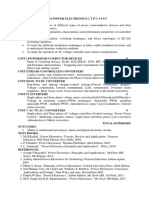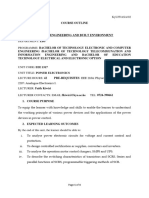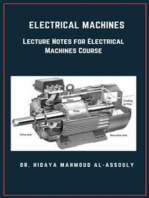EE2301 Power Electronics Syllabus
EE2301 Power Electronics Syllabus
Uploaded by
pugazhendiraCopyright:
Available Formats
EE2301 Power Electronics Syllabus
EE2301 Power Electronics Syllabus
Uploaded by
pugazhendiraCopyright
Available Formats
Share this document
Did you find this document useful?
Is this content inappropriate?
Copyright:
Available Formats
EE2301 Power Electronics Syllabus
EE2301 Power Electronics Syllabus
Uploaded by
pugazhendiraCopyright:
Available Formats
EE2301 POWER ELECTRONICS LTPC3003
OBJECTIVES
• To get an overview of different types of power semi-conductor devices and their switching
characteristics.
• To understand the operation, characteristics and performance parameters of controlled
rectifiers.
• To study the operation, switching techniques and basic topologies of DC-DC switching
regulators.
• To learn the different modulation techniques of pulse width modulated inverters and to
understand the harmonic reduction methods.
• To study the operation of AC voltage controller and Matrix converters.
• To study simple applications
UNIT I POWER SEMI-CONDUCTOR DEVICES 9
Study of switching devices, - Frame, Driver and snubber circuit of SCR, TRIAC, BJT,
IGBT, MOSFET, - Turn-on and turn-off characteristics, switching losses, Commutation
circuits for SCR.
UNIT II PHASE-CONTROLLED CONVERTERS 9
2-pulse, 3-pulse and 6-pulse converters – Effect of source inductance – performance
parameters – Reactive power control of converters – Dual converters - Battery charger.
UNIT III DC TO DC CONVERTER 9
Step-down and step-up chopper - Time ratio control and current limit control – Buck,
boost, buck-boost converter, concept of Resonant switching - SMPS.
UNIT IV INVERTERS 9
Single phase and three phase (both 120º mode and 180 º mode) inverters - PWM
techniques: Sinusoidal PWM, modified sinusoidal PWM - multiple PWM – Introduction
to space vector modulations - Voltage and harmonic control - Series resonant inverter -
Current source inverter.
UNIT V AC TO AC CONVERTERS 9
Single phase AC voltage controllers – Multistage sequence control - single and three
phase cycloconverters –Introduction to Integral cycle control, Power factor control and
Matrix converters.
TOTAL: 45 PERIODS
TEXT BOOKS
1. M.H. Rashid, ‘Power Electronics: Circuits, Devices and Applications’, Pearson Education, PHI
Third edition, New Delhi 2004.
2. Philip T.Krein, “Elements of Power Electronics” Oxford University Press, 2004 Edition.
REFERENCES
1. Ashfaq Ahmed Power Electronics for Technology Pearson Education, Indian reprint,
2003.
2. P.S.Bimbra “Power Electronics” Khanna Publishers, third Edition 2003.
3. Ned Mohan, Tore.M.Undeland, William.P.Robbins, ‘Power Electronics: Converters,
Applications and Design’, John Wiley and sons, third edition, 2003.
You might also like
- Beginning C Sharp Programming With Unity Visual Studio EditionDocument593 pagesBeginning C Sharp Programming With Unity Visual Studio EditionVũ Hải100% (3)
- Lecture Notes - Power Electronics PDFDocument197 pagesLecture Notes - Power Electronics PDFM.T. KadamNo ratings yet
- General Journal: Date Account Titles and Explanation PR DebitDocument26 pagesGeneral Journal: Date Account Titles and Explanation PR DebitLaica Cardenio100% (3)
- 06 Griswold Vs Connecticut - DIGESTDocument1 page06 Griswold Vs Connecticut - DIGESTKarez MartinNo ratings yet
- Ee6503 Power Electronics SyllabusDocument1 pageEe6503 Power Electronics SyllabussivaNo ratings yet
- EE8552 POWER ELECTRONICS SyllabusDocument1 pageEE8552 POWER ELECTRONICS SyllabuscoolrajeeeNo ratings yet
- Introduction To Power ElectronicsDocument9 pagesIntroduction To Power ElectronicsSathiya NathanNo ratings yet
- Introduction To Power ElectronicsDocument9 pagesIntroduction To Power ElectronicsSathiya NathanNo ratings yet
- GeiDocument2 pagesGeisansureNo ratings yet
- Analysis and Design of InvertersDocument1 pageAnalysis and Design of Invertersமுத்து குமார்No ratings yet
- SmpsDocument1 pageSmpsgok140% (1)
- PED Syllabus FinalDocument24 pagesPED Syllabus Finalsaravanan_KLUNo ratings yet
- Analysis of Power Electronic Converters: Hours Per Week: L T P C Total Hours: L T PDocument2 pagesAnalysis of Power Electronic Converters: Hours Per Week: L T P C Total Hours: L T PGoriparthi SambasievaraavNo ratings yet
- Power ElectronicsDocument9 pagesPower ElectronicsSindhuja Selvam100% (2)
- Mlp-Ee 51Document11 pagesMlp-Ee 51prasad357No ratings yet
- Power Electronics SyllabusDocument2 pagesPower Electronics SyllabusvrushaliNo ratings yet
- B.E Semester: IV Electrical Engineering: Power Semi-Conductor DevicesDocument2 pagesB.E Semester: IV Electrical Engineering: Power Semi-Conductor Devicesvatsalshah24No ratings yet
- Pe 2Document17 pagesPe 2Er NishantNo ratings yet
- BMR PE Syllabus R17 NewDocument3 pagesBMR PE Syllabus R17 NewRajesh Reddy KakarlaNo ratings yet
- PE Lesson PlanDocument10 pagesPE Lesson PlanAnbalagan GuruNo ratings yet
- Course Outline: Electrical Machines Technology ProgramDocument3 pagesCourse Outline: Electrical Machines Technology ProgramAhas AlqNo ratings yet
- Pe NotesDocument196 pagesPe Notesdilawar sumraNo ratings yet
- Ee8004 Modern Power Converters SyllabusDocument2 pagesEe8004 Modern Power Converters SyllabussignjpcoeNo ratings yet
- Eee 2317 Power Electronics Course OutlineDocument4 pagesEee 2317 Power Electronics Course OutlinemcclottryNo ratings yet
- PENUnit 1Document72 pagesPENUnit 1Naman NamanNo ratings yet
- Ee 917 Modern Power Electronic ConvertersDocument2 pagesEe 917 Modern Power Electronic ConvertersRekhamtr0% (1)
- Power Electronics - IIDocument3 pagesPower Electronics - IIfgzone50% (2)
- 5TH Sem SyllabusDocument16 pages5TH Sem SyllabusHunter HarshaNo ratings yet
- 5basic Electrical and Electronics EngineeringDocument2 pages5basic Electrical and Electronics Engineeringpurushotham1982No ratings yet
- Lecture1 Syllabus IntroDocument21 pagesLecture1 Syllabus Introperumburesuresh3762No ratings yet
- 22ee009 Modern Rectifiers and Resonant ConvertersDocument3 pages22ee009 Modern Rectifiers and Resonant ConvertersNANDHAKUMAR ANo ratings yet
- MDU B.tech Electrical Engineering 5th Sem SyllabusDocument8 pagesMDU B.tech Electrical Engineering 5th Sem SyllabusDhruv AhujaNo ratings yet
- Eee - R2019 - SyllabusDocument6 pagesEee - R2019 - SyllabusVishnuNo ratings yet
- Power ElectronicsDocument1 pagePower ElectronicsShahanas P SNo ratings yet
- PHD Entrance TestDocument3 pagesPHD Entrance TestmjrsudhakarNo ratings yet
- Power Electronics Engineering Questions BankDocument2 pagesPower Electronics Engineering Questions BankbhvnghhNo ratings yet
- Power Electronics and DrivesDocument2 pagesPower Electronics and DrivesAlfredo VMNo ratings yet
- Pe Notes PDFDocument197 pagesPe Notes PDFupender raoNo ratings yet
- Pe NotesDocument197 pagesPe NotesBrreetrtreSwewtreeNo ratings yet
- Pe NotesDocument197 pagesPe NotesAlfonsoNo ratings yet
- Pe Notes PDFDocument197 pagesPe Notes PDFArunkuma81No ratings yet
- Pe Notes PDFDocument197 pagesPe Notes PDFjohn Anand PaulNo ratings yet
- Pe Notes PDFDocument197 pagesPe Notes PDFKartikNo ratings yet
- EEE4040 Power Electronics - 2022Document71 pagesEEE4040 Power Electronics - 2022kajoba saluzhingaNo ratings yet
- EE305 Power ElectronicsDocument2 pagesEE305 Power ElectronicshaseenaNo ratings yet
- PE LessonPlanDocument4 pagesPE LessonPlanNarasimman DonNo ratings yet
- Power Electronics: OrientationDocument41 pagesPower Electronics: OrientationchandueeeNo ratings yet
- Pe IntroductionDocument31 pagesPe IntroductionJunaxic MuxicNo ratings yet
- Concept of Power ElectronicsDocument23 pagesConcept of Power ElectronicsMuttoju VaishnaviNo ratings yet
- 3710713-Power Electronics & ApplicationDocument3 pages3710713-Power Electronics & ApplicationTanvi IsraniNo ratings yet
- Ece-Vii-Power Electronics (10ec73) - Notes PDFDocument264 pagesEce-Vii-Power Electronics (10ec73) - Notes PDFafzal646100% (3)
- Jawaharlal Nehru Technological UniversityDocument5 pagesJawaharlal Nehru Technological UniversityMahesh J. UmaNo ratings yet
- Power Electronics L.PDocument2 pagesPower Electronics L.PAtib ShaikhNo ratings yet
- Power ElectronicsDocument7 pagesPower ElectronicsNarasimman DonNo ratings yet
- Course Content EE3203 Power ElectronicsDocument1 pageCourse Content EE3203 Power ElectronicsArun KaruppaswamyNo ratings yet
- Power Electronics: Lecture Notes of Power Electronics CourseFrom EverandPower Electronics: Lecture Notes of Power Electronics CourseNo ratings yet
- Power Electronics and Energy Conversion Systems, Fundamentals and Hard-switching ConvertersFrom EverandPower Electronics and Energy Conversion Systems, Fundamentals and Hard-switching ConvertersNo ratings yet
- Electrical Machines: Lecture Notes for Electrical Machines CourseFrom EverandElectrical Machines: Lecture Notes for Electrical Machines CourseNo ratings yet
- Generation and Transmission of Electric Power: Lecture Notes of the Generation and Transmission of Electric Power CourseFrom EverandGeneration and Transmission of Electric Power: Lecture Notes of the Generation and Transmission of Electric Power CourseNo ratings yet
- Methods for Increasing the Quality and Reliability of Power System Using FACTS DevicesFrom EverandMethods for Increasing the Quality and Reliability of Power System Using FACTS DevicesNo ratings yet
- Reference Guide To Useful Electronic Circuits And Circuit Design Techniques - Part 2From EverandReference Guide To Useful Electronic Circuits And Circuit Design Techniques - Part 2No ratings yet
- Reference Guide To Useful Electronic Circuits And Circuit Design Techniques - Part 1From EverandReference Guide To Useful Electronic Circuits And Circuit Design Techniques - Part 1Rating: 2.5 out of 5 stars2.5/5 (3)
- EE6005 Power Quality Sem ViiiDocument2 pagesEE6005 Power Quality Sem ViiipugazhendiraNo ratings yet
- DC DC ConverterDocument25 pagesDC DC ConverterpugazhendiraNo ratings yet
- Lecture #9 Control Engineering Review Slides: Reference: Textbook by Phillips and HaborDocument35 pagesLecture #9 Control Engineering Review Slides: Reference: Textbook by Phillips and HaborpugazhendiraNo ratings yet
- What Are The Three Types of Speed ControlDocument5 pagesWhat Are The Three Types of Speed ControlpugazhendiraNo ratings yet
- 2 Marks (Questions & Answers) : Geared Coupling Power SupplyDocument5 pages2 Marks (Questions & Answers) : Geared Coupling Power SupplypugazhendiraNo ratings yet
- EE 1351 Solid State Drives UNIT 1 - Drive CharacteristicsDocument1 pageEE 1351 Solid State Drives UNIT 1 - Drive CharacteristicspugazhendiraNo ratings yet
- Unit I V 2 Mark Question Answer 16 Mark QuestionsDocument23 pagesUnit I V 2 Mark Question Answer 16 Mark QuestionspugazhendiraNo ratings yet
- Stepper Motor.Document172 pagesStepper Motor.pugazhendira50% (2)
- Cri 1Document20 pagesCri 1pugazhendiraNo ratings yet
- Voltage Level ShiftingDocument5 pagesVoltage Level ShiftingpugazhendiraNo ratings yet
- Power Supply NotesDocument48 pagesPower Supply NotespugazhendiraNo ratings yet
- Fuzzy Sets and Fuzzy LogicDocument67 pagesFuzzy Sets and Fuzzy LogicpugazhendiraNo ratings yet
- Formative SHE Task History - of - The - Atom - WorksheetDocument3 pagesFormative SHE Task History - of - The - Atom - WorksheetemuhpbeNo ratings yet
- Writing U6 WorksheetDocument3 pagesWriting U6 WorksheetmauNo ratings yet
- Thesis On Food Safety PDFDocument7 pagesThesis On Food Safety PDFlaurasmithdesmoines100% (2)
- 21 00202 Proposed Construction of Basketball Court Roofing at Bugallon PlazaDocument84 pages21 00202 Proposed Construction of Basketball Court Roofing at Bugallon PlazaJN CNo ratings yet
- Indian Psychiatric Society in Association With Medical Wing, R.E.R.FDocument608 pagesIndian Psychiatric Society in Association With Medical Wing, R.E.R.FJerry JacobNo ratings yet
- UPCST G - GuidelinesDocument46 pagesUPCST G - Guidelineshimanshu100% (1)
- Bab I Komitmen Rumah TanggaDocument14 pagesBab I Komitmen Rumah TanggaCahyacayNo ratings yet
- Tristan TaorminoDocument252 pagesTristan Taorminomaquis870% (1)
- Trafocare-2024 v8Document20 pagesTrafocare-2024 v8benlahnecheNo ratings yet
- Chapter 13 IntaccDocument2 pagesChapter 13 IntaccJhuliane RalphNo ratings yet
- PHYSICS IMPORTANT PROBLEMS 2nd PucDocument12 pagesPHYSICS IMPORTANT PROBLEMS 2nd Pucwarriorhitesh48No ratings yet
- Din 18808Document20 pagesDin 18808Silmar BiazioliNo ratings yet
- ODC Form 1A: Procedure PerformedDocument5 pagesODC Form 1A: Procedure PerformedJenny S. SaquinNo ratings yet
- Epp He Q2 PTDocument5 pagesEpp He Q2 PTWendy Lyn LabateteNo ratings yet
- Import & Export ManagementDocument21 pagesImport & Export ManagementManjeet Ojha0% (1)
- Grammar Friends 3Document126 pagesGrammar Friends 3luu dinhNo ratings yet
- Weberbloc Fix NDocument2 pagesWeberbloc Fix NCharbel AchkoutyNo ratings yet
- Festival DanceDocument49 pagesFestival DanceErika MaeNo ratings yet
- SEVEN STEDS To Achieving?: Financial Victory Through™Document132 pagesSEVEN STEDS To Achieving?: Financial Victory Through™bindiyamfNo ratings yet
- Transformer Stations and Renewable Energy Equipment Res 2023Document72 pagesTransformer Stations and Renewable Energy Equipment Res 2023delmarlauranNo ratings yet
- Uber AssignmentDocument37 pagesUber AssignmentSheraz KhanNo ratings yet
- Unit 7. Revision and ConclusionDocument5 pagesUnit 7. Revision and ConclusionAryla AdhiraNo ratings yet
- Admission Schedule: CCB: RC: PI: Gfi: SfiDocument6 pagesAdmission Schedule: CCB: RC: PI: Gfi: Sfirahul989No ratings yet
- Universal Basic Income: Pre-ReadingDocument13 pagesUniversal Basic Income: Pre-ReadingChagualo Alpargate LuisNo ratings yet
- Elliott Wave - Short Term UpdateDocument12 pagesElliott Wave - Short Term UpdateNazerrul Hazwan KamarudinNo ratings yet
- SkimmingDocument3 pagesSkimmingCharlene NaungayanNo ratings yet




































































































